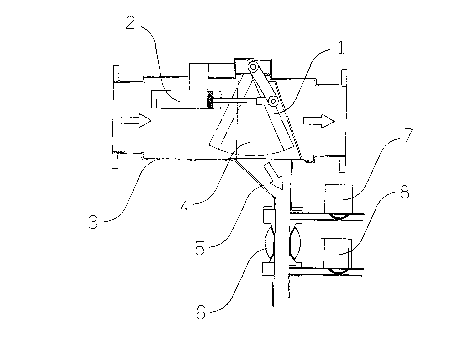Some of the information on this Web page has been provided by external sources. The Government of Canada is not responsible for the accuracy, reliability or currency of the information supplied by external sources. Users wishing to rely upon this information should consult directly with the source of the information. Content provided by external sources is not subject to official languages, privacy and accessibility requirements.
Any discrepancies in the text and image of the Claims and Abstract are due to differing posting times. Text of the Claims and Abstract are posted:
| (12) Patent: | (11) CA 2120107 |
|---|---|
| (54) English Title: | APPARATUS FOR SAMPLING A MATERIAL CONTAINING SOLIDS |
| (54) French Title: | APPAREIL POUR L'ECHANTILLONNAGE DE MATIERES CONTENANT DES SOLIDES |
| Status: | Term Expired - Post Grant Beyond Limit |
| (51) International Patent Classification (IPC): |
|
|---|---|
| (72) Inventors : |
|
| (73) Owners : |
|
| (71) Applicants : |
|
| (74) Agent: | NORTON ROSE FULBRIGHT CANADA LLP/S.E.N.C.R.L., S.R.L. |
| (74) Associate agent: | |
| (45) Issued: | 2000-05-16 |
| (22) Filed Date: | 1994-03-28 |
| (41) Open to Public Inspection: | 1994-09-30 |
| Examination requested: | 1995-10-18 |
| Availability of licence: | N/A |
| Dedicated to the Public: | N/A |
| (25) Language of filing: | English |
| Patent Cooperation Treaty (PCT): | No |
|---|
| (30) Application Priority Data: | ||||||
|---|---|---|---|---|---|---|
|
The invention relates to an apparatus for sampling a solids-bearing material that flows or is made to flow, the said apparatus comprising a sampling member (4) set in contact with the flowing material, and a sampling conduit (5) connected to the sampling member (4) in order to conduct the sample flow passing through the sampling member (4) to further treatment. According to the invention, in connection with the sampling member (4) there is movably installed a cleaning member (1), so that the cleaning member (1) can be at least partly inserted to the sampling member (4) when in working position.
L'invention concerne un dispositif pour l'échantillonnage d'un matériau contenant des solides qui s'écoule ou qui est amené à s'écouler, ledit dispositif comprenant un élément de prélèvement (4) mis en contact avec le matériau qui s'écoule, et un conduit de prélèvement (5) relié à l'élément de prélèvement (4) afin de conduire l'échantillon de débit traversant l'élément de prélèvement (4) à un traitement supplémentaire. Selon l'invention, en connexion avec l'élément de prélèvement (4) est installé de façon mobile un élément de nettoyage (1), de sorte que l'élément de nettoyage (1) puisse être au moins partiellement inséré dans l'élément de prélèvement (4) lorsqu'il est en position de travail.
Note: Claims are shown in the official language in which they were submitted.
Note: Descriptions are shown in the official language in which they were submitted.

2024-08-01:As part of the Next Generation Patents (NGP) transition, the Canadian Patents Database (CPD) now contains a more detailed Event History, which replicates the Event Log of our new back-office solution.
Please note that "Inactive:" events refers to events no longer in use in our new back-office solution.
For a clearer understanding of the status of the application/patent presented on this page, the site Disclaimer , as well as the definitions for Patent , Event History , Maintenance Fee and Payment History should be consulted.
| Description | Date |
|---|---|
| Inactive: Expired (new Act pat) | 2014-03-28 |
| Inactive: IPC from MCD | 2006-03-11 |
| Inactive: Cover page published | 2000-05-16 |
| Grant by Issuance | 2000-05-16 |
| Inactive: Final fee received | 2000-02-15 |
| Pre-grant | 2000-02-15 |
| Notice of Allowance is Issued | 1999-09-13 |
| Notice of Allowance is Issued | 1999-09-13 |
| Letter Sent | 1999-09-13 |
| Inactive: Status info is complete as of Log entry date | 1999-09-03 |
| Inactive: Application prosecuted on TS as of Log entry date | 1999-09-03 |
| Inactive: Approved for allowance (AFA) | 1999-08-20 |
| Request for Examination Requirements Determined Compliant | 1995-10-18 |
| All Requirements for Examination Determined Compliant | 1995-10-18 |
| Application Published (Open to Public Inspection) | 1994-09-30 |
There is no abandonment history.
The last payment was received on 2000-02-28
Note : If the full payment has not been received on or before the date indicated, a further fee may be required which may be one of the following
Please refer to the CIPO Patent Fees web page to see all current fee amounts.
Note: Records showing the ownership history in alphabetical order.
| Current Owners on Record |
|---|
| OUTOKUMPU MINTEC OY |
| Past Owners on Record |
|---|
| KARI MANN |
| LAURI KARHU |